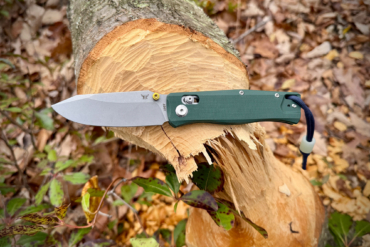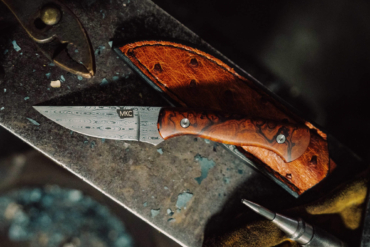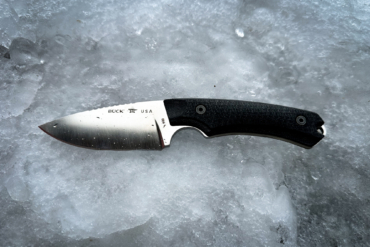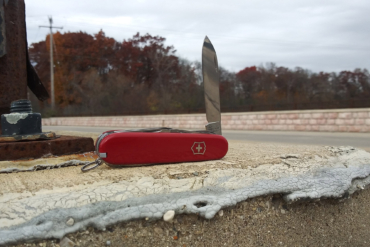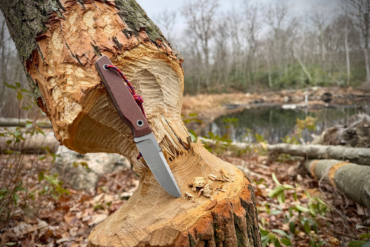[leadin]It might seem like these two things NEVER mix, but the truth is, not long ago every farm kid had a knife.[/leadin]

Times have changed — the world is full of helicopter parents and everything has been Nerf-ified. But teaching a child how to use a knife is a great way to hone hand-eye coordination, make them feel more confident in their abilities, and instill respect, but not fear, of potentially dangerous tools.
Here is my disclaimer: children are precious and knives can be dangerous, so pay attention, never push them, and always stress safety first. Or the shorter version –don’t be stupid.
Knives Are Tools, Not Toys
From the beginning, children need to be taught that knives are tools, not toys. This is a fundamental point in learning about the world, that some things must be treated with respect.
With this come boundaries to be set by a parent. Children must know that knives are not to be brought to school or other social situations, and they are not to be played with among groups of their peers. A knife is a responsibility. Set these boundaries early, and be sure children respect them.
Additionally, use early teaching as a time to set expectations on caring for tools. Knives (and all tools) should be put away dry. Blades should be kept sharp. Let them watch you hone a blade and try it for themselves as dexterity improves.
Fixed Blades Are Easiest For First Timers
Starting out, I think it’s best to avoid folding knives. Their mechanisms are hard for kids to operate and they can pinch themselves on the pivots. The lock is also difficult, even on the simplest designs, to open and close. There are just too many issues with a folder for little hands to figure out.

I strongly prefer fixed blades for beginners. It’s also helpful to start out in the kitchen, as opposed to the outdoors. The cutting media in the kitchen is so much more controlled and controllable. There are no nasty knots or dirty things to bang into.
To start my son off, we gave him a small, serrated knife with a kid-centric design. It had a rounded tip and a rubber handle with a guard in the front AND the back (much like the beloved Ethan Becker designed handle found on Kabar fixed blades). It also looked like a puppy.
Equipped with that, my son learned to slice and chop and he helped prepare many a delicious salad. Slicing through the stems of lettuce leaves and chopping carrots gave him a sense of the motions but offered little resistance compared to the traditional starting point for knife skills, something like whittling.
After a child shows a mastery of the kitchen knife, I think you can move them up to something like a small outdoor fixed blade. So-called Bird and Trout models (like the CRKT Mossback Bird and Trout) do well here.

They have enough cutting power to feel like real knives (because they are) without being overwhelming. Children explore their world by destruction and deconstruction, and a knife is a supremely good tool on that account. I let my son go out in the woods and bang on some dead trees with his Mossback Bird and Trout, and he loves it.
A few tips — bring a pair of safety glasses to help with flying chips and attach a brightly colored lanyard to the knife to prevent them from tossing it and helping them find it when they inevitably do.
Once they master that, it might be fun to transition them to bigger knives, something with a blade around four to five inches.

They will still do a lot of hacking, but you can start to teach them finer points, like how to properly chop down a tree, how to sharpen the end of a stick for use in a fire, and, of course, whittling.
I know the Boy Scouts start out with whittling but that means they are: a) using a folding knife generally; b) starting with a high-skill, heavy-resistance task. Whittling, it seems to me is an advanced skill.
If the child shows a mastery of the larger blade, then I would think about transitioning to a folder. My son told me a few days ago that he liked Spydercos the best because he can open them. I didn’t understand exactly what he meant until I watched him — he lifts open the blade with two fingers going through the hole atop the blade. It’s not what was intended, but it is much easier than hitting a thumb stud, using a flipper, or, geez, trying the daunting nail knick.
Good Starter Knives For Kids
There are a surprising number of good knives for kids. I like the bird and trout designs as a starting point. They are usable in little hands and they will remain a useful knife for their entire lives, later transitioning to their intended use as a detail-oriented outdoor knife.
Kids also really like mutli-tools, and, to that end, nothing comes close to the Leatherman Leap. It is purpose-built for little hands and even has a removable knife blade.

Finally, Knives Ship Free has a Knives for Kids program that offers a basic folder for very little money.
It will give them confidence as well as some useful things to know. And it will help you with your helicopter parent tendencies.


